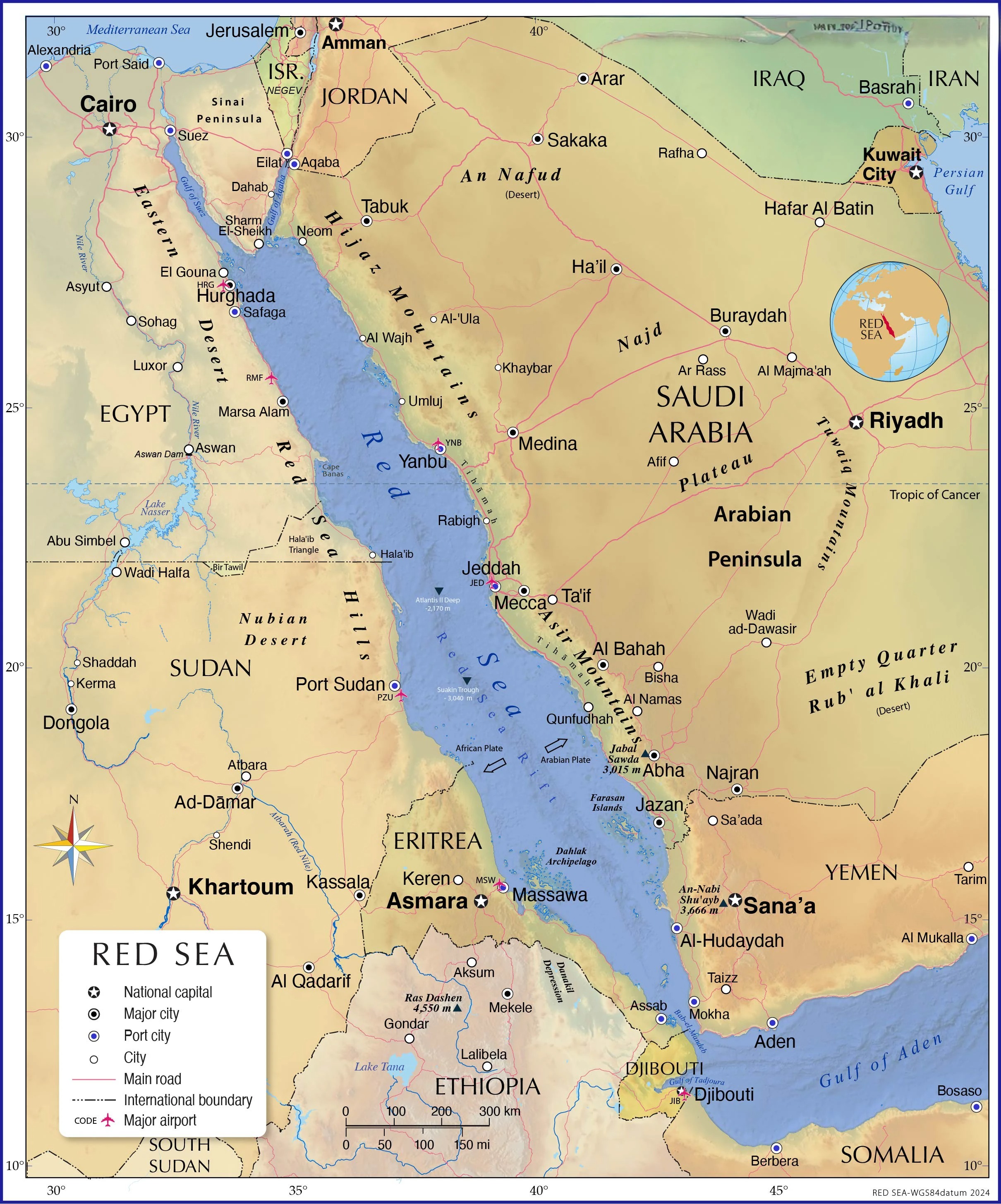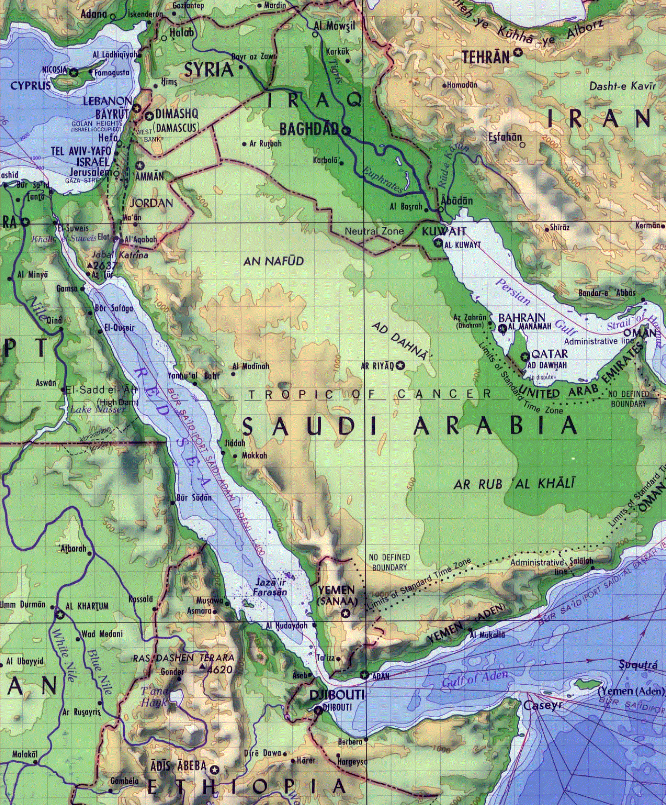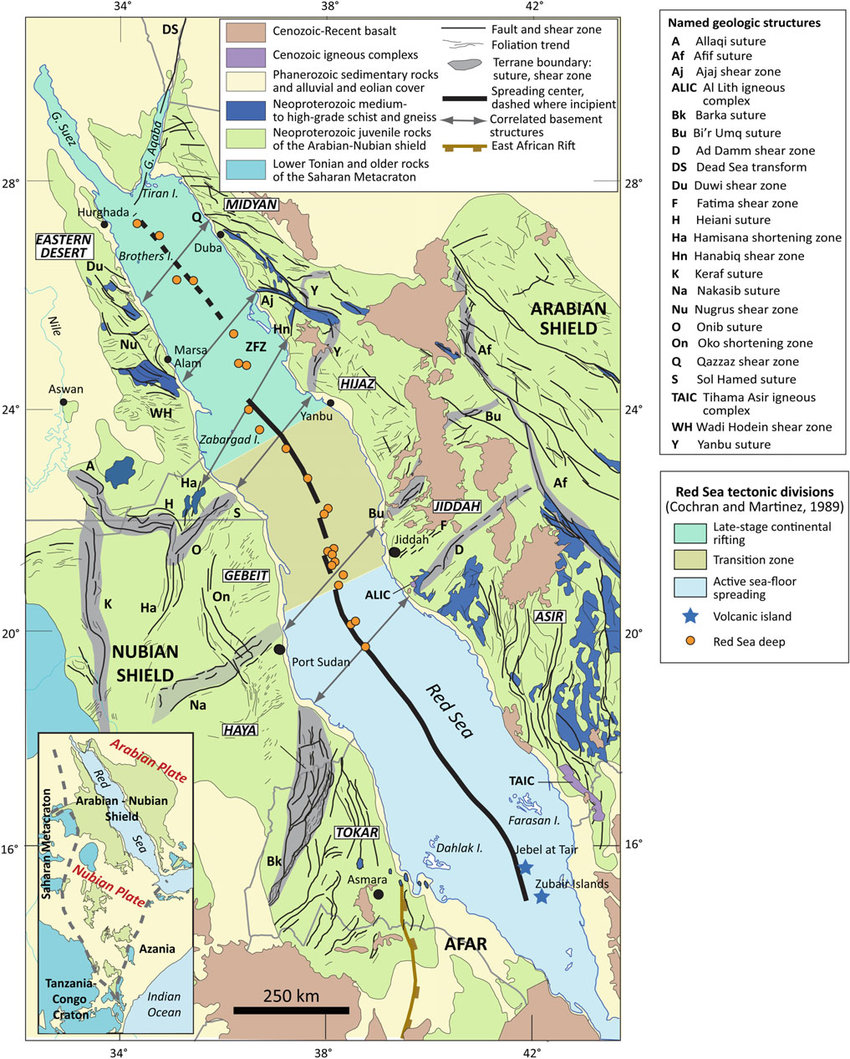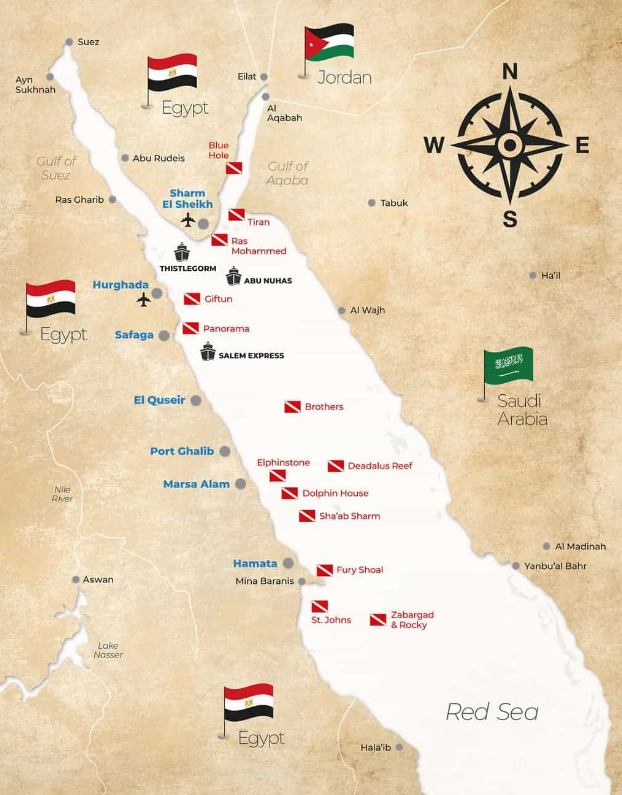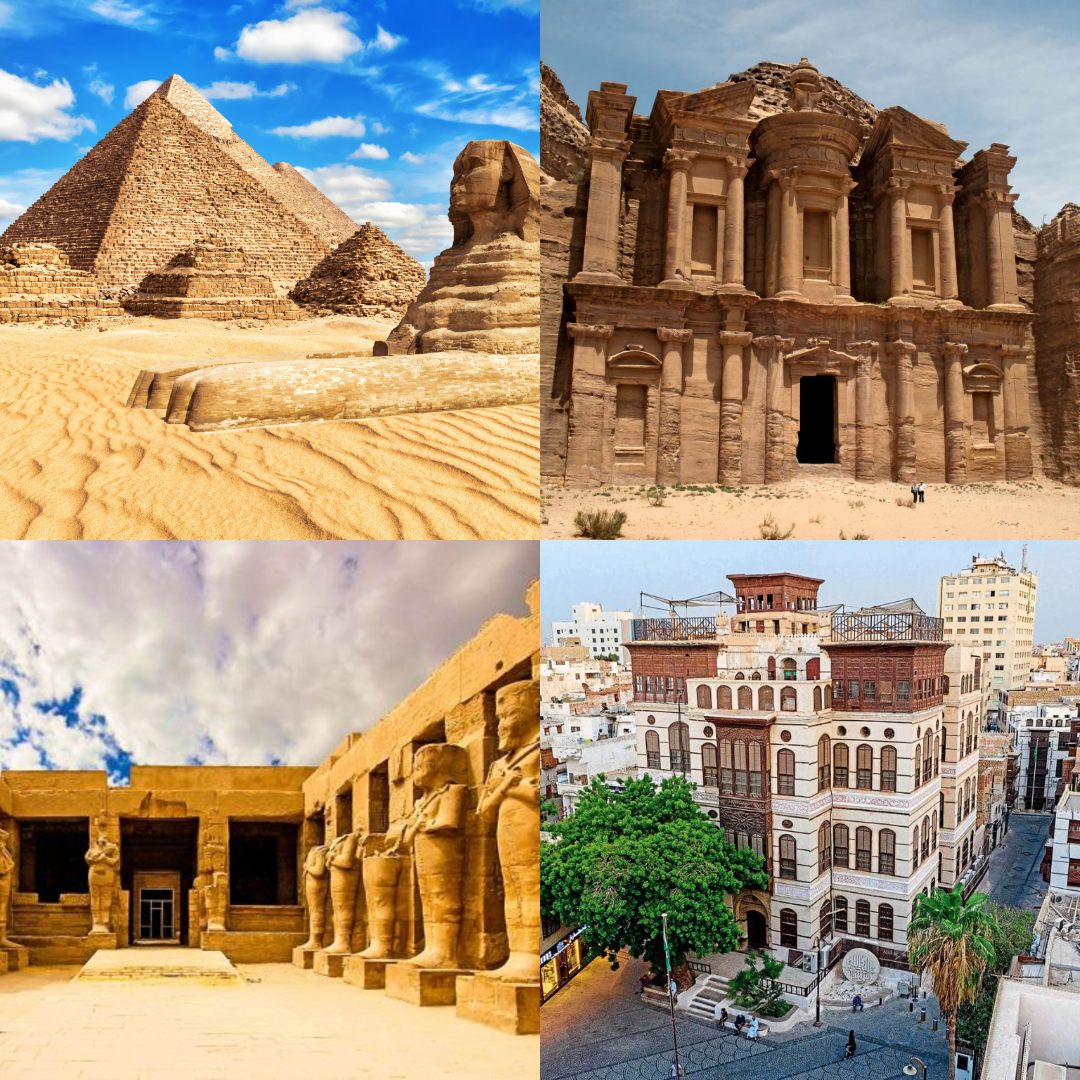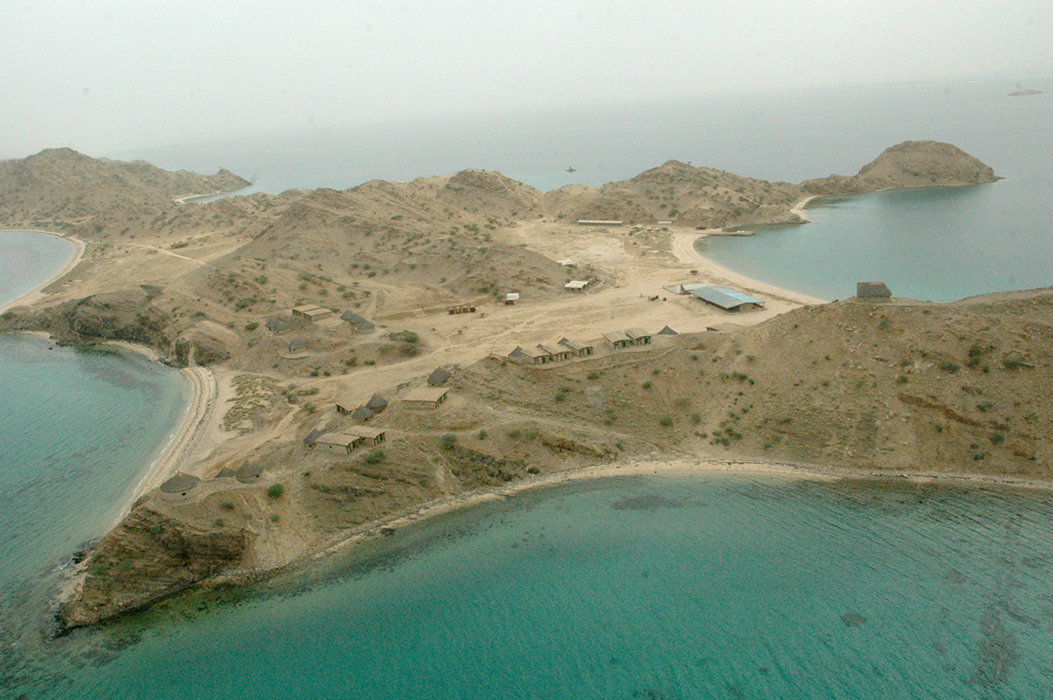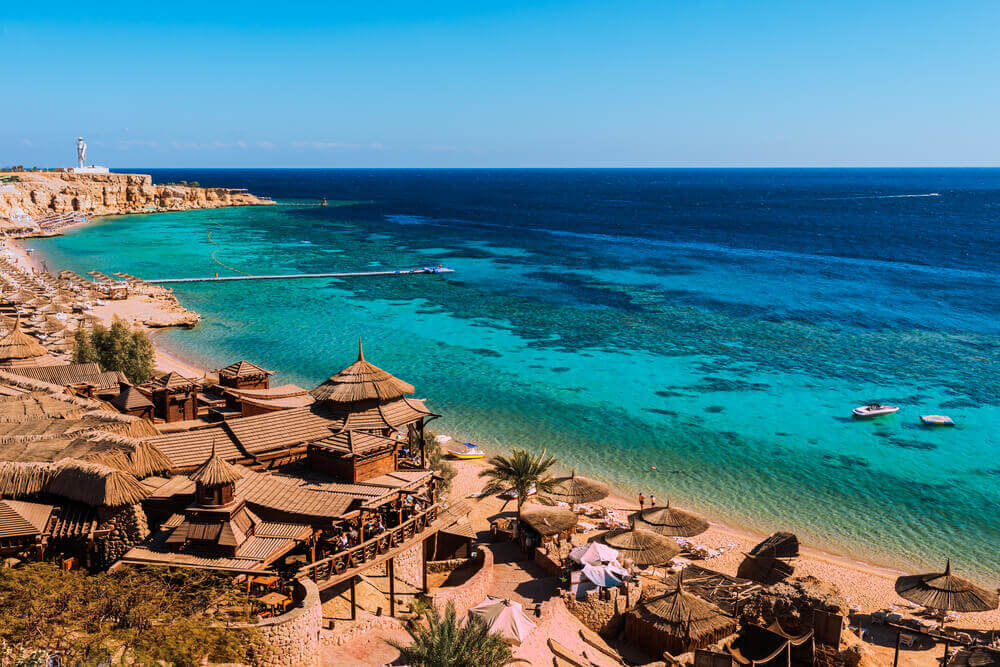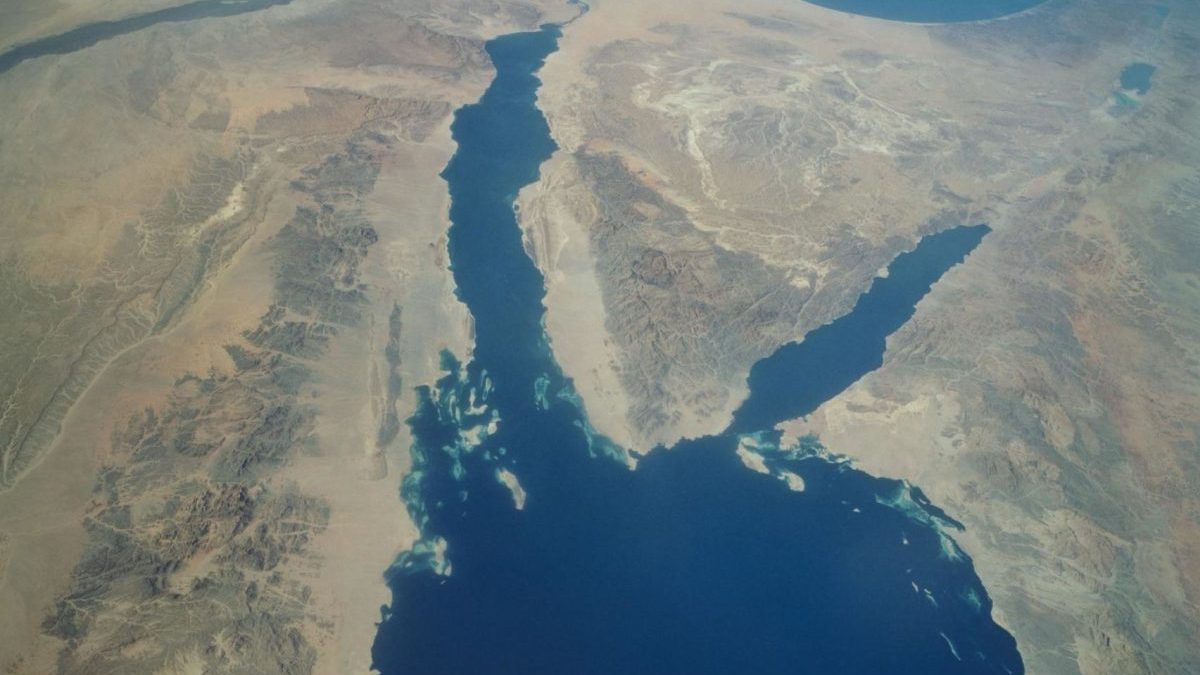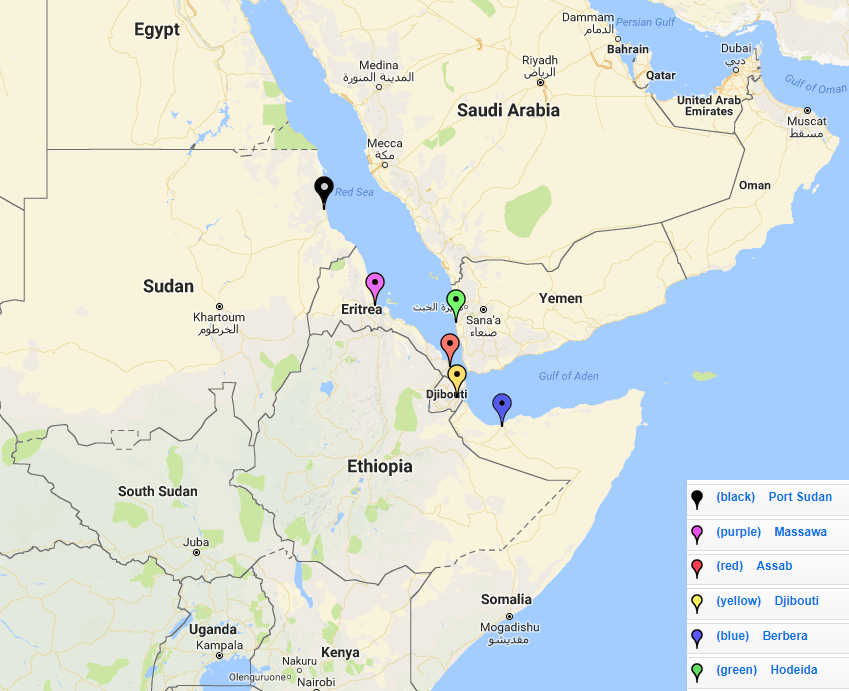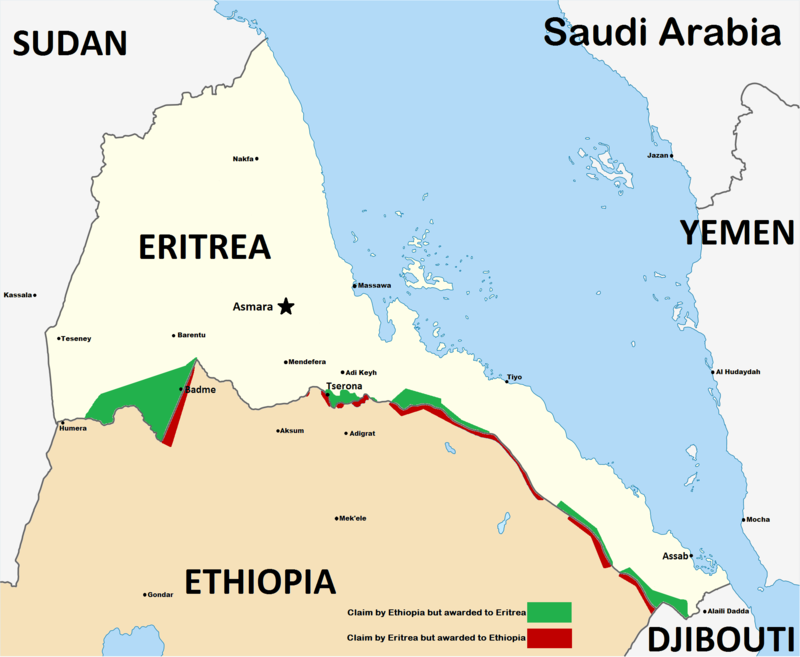Red Sea Map - A Comprehensive Guide
The Red Sea, a breathtaking expanse of water, separates Africa from the Arabian Peninsula. Explore its geography and discover its unique features with this comprehensive guide.
Author:Finn WildeReviewer:Michael RachalApr 06, 202524.3K Shares325.2K Views
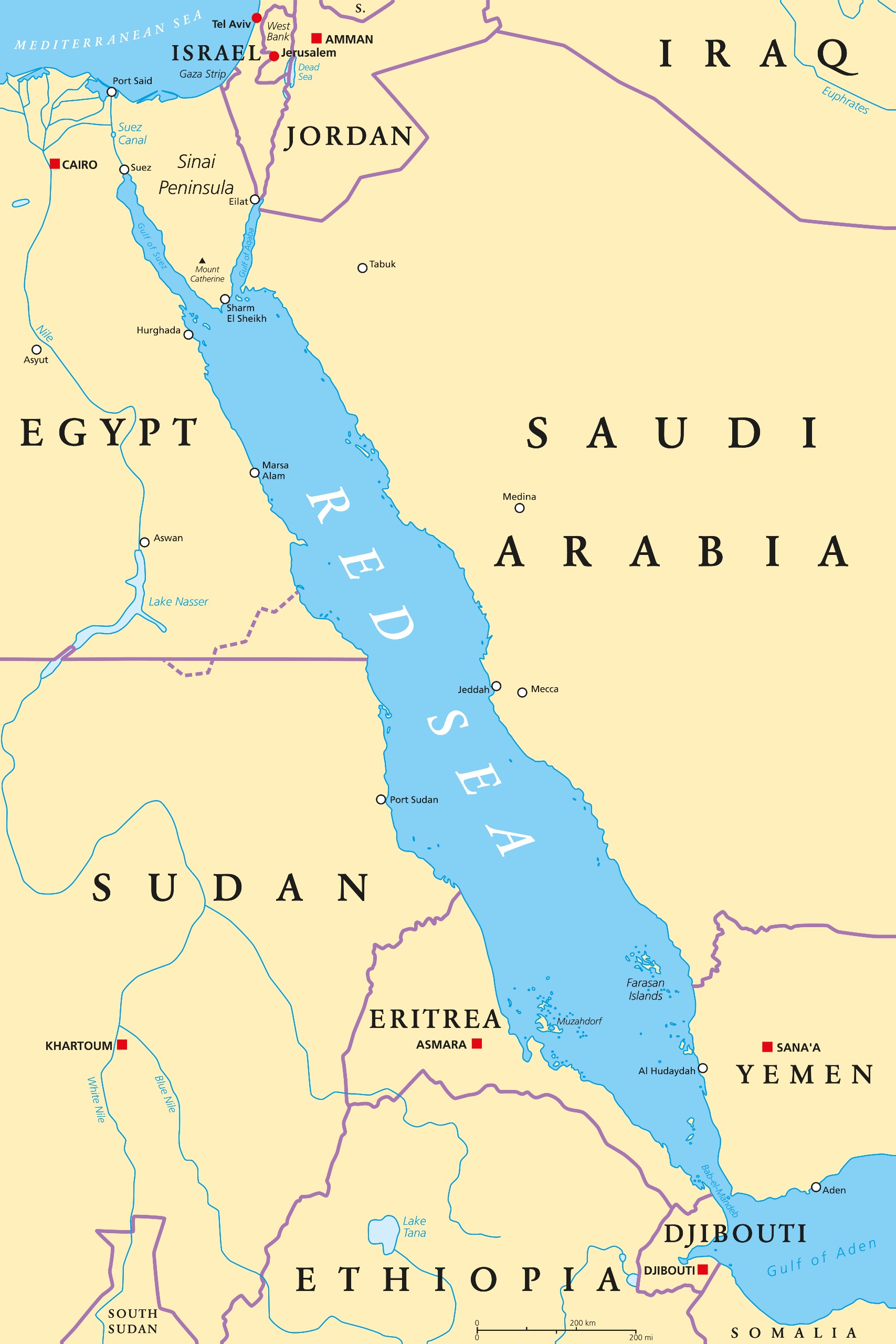
The Red Sea, a body of water between northeastern Africa and the Arabian Peninsula, stands as one of the most significant waterways in the world. Spanning over 438,000 km², about twice the size of the United Kingdom, it serves as a crucial corridor for global maritime traffic. This article explores the geography, environmental importance, and ongoing challenges faced by this vital sea.
Geography And Location
The Red Sea stretches approximately 1,960 kilometers (1,220 miles) from the Bab el-Mandeb Strait in the south to the Sinai Peninsula in the north. Its width varies from 360 kilometers at its broadest point to just 29 kilometers at its narrowest stretch through the Bab el-Mandeb Strait.
Geopolitically, the Red Sea borders several countries: in the east, Saudi Arabiaand Yemen, and in the west, Egypt, Sudan, Eritrea, and Djibouti. Israel and Jordan also have limited access through their ports on the Gulf of Aqaba.
The Red Sea connects to the Mediterranean Sea through the Suez Canal, a critical link for global trade. This man-made waterway, opened in 1869, enables ships to bypass the lengthy route around Africa, providing the shortest sea link between Asia and Europe.
Its strategic location has made it a significant route for the transport of goods, especially oil and gas, with 12 to 16% of global trade passing through the region.
The Red Sea was formed due to the tectonic movements of the African and Arabian plates, a process that began 55 million years ago. This separation created the Red Sea Trench and continues to cause geological activity, including volcanic eruptions and the spreading of the seabed. This ongoing process shapes the underwater landscape, creating deep central trenches and relatively shallow continental shelves on either side.
One of the most fascinating features of the Red Sea is its warm and clear waters, which support thriving coral reefs and abundant marine life. The sea’s shallow regions, such as the Gulf of Aqaba and the Gulf of Suez, are ideal for diverse ecosystems.
Coral reefs here are among the healthiest in the world, a major attraction for divers and marine researchers. The Red Sea also hosts rare brine pools-dense, saline bodies of water that don’t mix with the surrounding sea, creating a striking, lake-like appearance.
Ecological Importance And Biodiversity
The Red Sea is home to a rich array of flora and fauna, with over 1,200 species of fish, many of which are endemic to the region. Its coral reefs, particularly those near Egypt's Sharm el-Sheikh and Sudan’s coastal areas, are vital to marine biodiversity.
The sea is also known for its coastal mangroves and sea grasses, which play a critical role in coastal protection and carbon sequestration.
Diving in the Red Sea has become an increasingly popular activity, attracting thousands of tourists annually to destinationslike Sharm el-Sheikh in Egypt and Aqaba in Jordan. The region is renowned for its crystal-clear waters and vibrant marine life, making it one of the world’s premier diving spots.
The Red Sea On The Map: Key Facts And Visual Insights
Maps are indispensable tools for understanding the Red Sea, offering vital insights into its geography, environmental conditions, and the human activities that shape the region. From topographical to historical maps, each type provides a different lens through which we can better understand this crucial body of water.
Topographical Maps
Topographical maps illustrate the underwater landscape of the Red Sea, which is shaped by tectonic activity. Key features highlighted in these maps include:
- Red Sea Trench: The deep central trench that reaches depths of up to 3,040 meters(10,000 feet), making it one of the deepest gulfs in the world.
- Shallow Continental Shelves: On either side of the trench, the shelves are relatively shallow, supporting the region’s coral reefsand marine ecosystems.
- Underwater Mountains and Volcanoes: Geologically active areas, like the East African Rift Zone, are reflected in these maps, which show the shifting of tectonic plates and volcanic activity beneath the sea.
These maps are essential for both navigationand scientific research, helping to understand the Red Sea's unique geological makeup.
Nautical Charts
Nautical charts are specialized maps that provide detailed information crucial for maritime navigation. These charts focus on:
- Water Depths: Crucial for avoiding underwater obstacles, such as reefsand sandbanks.
- Currents and Tides: Understanding ocean currents is vital for ship routing and safe travel.
- Reefs and Hazards: Identifying areas like the Abu Ghalawa Reefand other submerged reefs to ensure safe passage for ships.
- Shipping Lanes: Designated shipping lanes, particularly around key ports like Jeddahand Port Sudan, ensure smooth and efficient maritime traffic.
Given the Red Sea’s role as a major international shipping route, these charts are critical for safe and efficient shippingoperations, supporting the global economy.
Geological Maps
Geological maps highlight the tectonic origins and active geological processes that formed the Red Sea:
- Rift Valley: The region lies along the East African Rift, where the African and Arabian platesare slowly moving apart. This map shows the structural features that have caused the widening of the Red Sea over millions of years.
- Volcanic Activity: Areas of volcanic activity are marked, particularly along the Afar Triple Junction, where the tectonic plates meet, causing both underwater and above-sea eruptions.
- Crust Formation: The geological maps demonstrate how the Red Sea’s basin is slowly being filled by newly-formed oceanic crust.
These maps provide valuable insights into the geological historyof the region, helping researchers understand the forces that shaped the Red Sea and continue to influence its development.
Diving Maps
For marine enthusiasts and researchers, diving maps are indispensable. These maps pinpoint:
- Popular Dive Sites: Locations like Sharm El Sheikh, Dahab, and Hurghada, known for their spectacular coral reefs and underwater biodiversity.
- Shipwrecks: The Red Sea is home to numerous historical shipwrecks, including those from World War II, which are popular with wreck divers.
- Coral Reefs: Mapping out the coral reef systems, such as the Straits of Tiranand Ras Mohammed National Park, helps in sustainable tourism and conservation efforts.
These maps are vital for promoting sustainable tourismand preserving the delicate marine ecosystems that are under threat from climate changeand overfishing.
Historical Maps
Historical maps offer a glimpse into the past and showcase how the Red Sea has evolved as a geopolitical hub. These maps typically feature:
- Ancient Trade Routes: Maps from ancient times depict the Incense Routeand other historical maritime trade routes that connected the Mediterranean, Arabian Peninsula, and East Africa.
- Port Locations: Ancient portslike Berenicein Egypt and Quseir al-Qadimare depicted, which played significant roles in ancient trade.
- Changing Borders and Control: Over centuries, different empires, from the Romansto the Ottomans, controlled various parts of the Red Sea, and these maps trace the shifting political landscape of the region.
These historical insights are crucial for understanding the cultural significanceof the Red Sea and its role in shaping the history of global commerce and geopolitics.
Dynamic Nature Of Maps In Understanding The Red Sea
Maps are not static representations; they serve as dynamic tools that help us understand the complex interplay of geological forces, human activities, and the delicate marine ecosystem of the Red Sea.
- Scientific Research: The Red Sea’s unique ecosystem and geological history require ongoing study to monitor climate changeimpacts, marine biodiversity, and tectonic activity.
- Conservation Efforts: Detailed maps are used by environmentalists and conservation groups to protect critical habitats and identify areas that need preservation.
- Tourism Planning: Sustainable tourism planning is guided by maps that help manage visitor flow to sensitive ecosystems like coral reefs.
These types of maps are crucial for marine research, conservation efforts, and planning sustainable tourism, ensuring the future health and accessibility of the Red Sea.
Attractions Along The Red Sea
The Red Sea is a paradise for both adventure seekers and those seeking relaxation. Its coastline is dotted with a myriad of resorts offering a diverse range of experiences.
Red Sea Resorts:
- Egypt:Sharm El-Sheikh, a vibrant resort city, is a renowned diving destination, boasting stunning coral reefs and diverse marine life. Hurghada, another popular choice, offers a blend of relaxation and adventure, with opportunities for diving, snorkeling, and desert safaris. Dahab, renowned for its laid-back atmosphere, attracts divers and windsurfers alike.
- Saudi Arabia:The Red Sea coast of Saudi Arabia is experiencing a tourism boom, with the development of luxury resorts and upscale destinations.
Historical And Archaeological Sites
- Pyramids of Giza, Egypt:Though slightly inland, these iconic structures are within reach for travelers exploring the Egyptian Red Sea coast.
- Luxor and Karnak Temples, Egypt:Accessible from Safaga, these ancient ruins offer a glimpse into Egypt's glorious past.
- Petra, Jordan:While not directly on the Red Sea, Petrais easily reached from Aqaba and is a UNESCO World Heritage site.
- Jeddah's Al-Balad, Saudi Arabia:This historic district showcases traditional architecture and the country's rich heritage.
Natural Wonders
- Ras Mohammed National Park, Egypt:Ras Mohammed National Park, Egypt-a protected area known for its vibrant coral reefs and abundant marine life, ideal for diving and snorkeling.
- The Dahlak Archipelago, Eritrea:An untouched paradise of over 100 islands with pristine beachesand diverse ecosystems.
- Mount Sinai, Egypt:A sacred site for many religions, offering stunning views and a spiritually significant experience.
Marine Activities
- Diving and Snorkeling:Explore famous dive sites like SS Thistlegorm (Egypt), Sanganeb Reef (Sudan), and the Blue Hole (Dahab, Egypt).
- Glass-Bottom Boats:Perfect for non-divers to witness the Red Sea's underwater beauty.
- Fishing Charters:Particularly popular in the waters near Saudi Arabia and Eritrea.
Beaches And Resorts
- Sharm El-Sheikh, Egypt:Known for its luxury resorts, nightlife, and vibrant coral reefs.
- Hurghada, Egypt:A family-friendly destination offering beaches, water sports, and island excursions.
- Eilat, Israel:Famous for its coral beach, dolphin reef, and lively waterfront.
Cultural Experiences
- Aqaba, Jordan:Offers a mix of modern amenities and historical charm, with bazaars and cultural festivals.
- Yanbu, Saudi Arabia:A historic trade hub with rich maritime traditions and growing ecotourism initiatives.
Pilgrimage Routes
- Jeddah to Mecca, Saudi Arabia:Many pilgrims pass through Jeddah, the gateway to the Islamic holy cities of Mecca and Medina.
- Ferry Routes for Hajj:Ports like Safaga and Yanbu facilitate pilgrims traveling to Saudi Arabia by sea.
Unique Geological Features
- Red Sea Rift:Witness the geological activity shaping the region’s landscape, visible in certain areas along the coast.
- Hot Springs in Eritrea:Known for their therapeutic properties and unique locations.
Pictures Of The Red Sea
The Red Sea is a photographer's dream. The crystal-clear waters, vibrant coral reefs, and diverse marine life create breathtaking underwater scenes. Imagine schools of colorful fish darting through coral formations, rays gliding gracefully through the water, and perhaps even a glimpse of a majestic sea turtle.
The sheer clarity of the Red Sea water, a result of its high salinity and limited freshwater input, allows for incredible underwater visibility, making it a photographer's paradise.
Major Port Cities On The Red Sea
The Red Sea is a vital maritime corridor, and its shores are lined with major port cities that play a crucial role in global trade.
Jeddah Islamic Port, Saudi Arabia:The primary port of Saudi Arabia, Jeddah is a bustling hub for international trade, handling a vast volume of cargo, including containers, general cargo, and livestock.
Port of Suez, Egypt:Located at the northern end of the Gulf of Suez, the Port of Suez is a strategic gateway connecting the Mediterranean Sea to the Red Sea. Its significance lies in its role in facilitating global trade by allowing ships to bypass the lengthy journey around the southern tip of Africa.
Port of Djibouti, Djibouti:Situated at the strategic Bab-el-Mandeb Strait, Djibouti serves as a vital transshipment point for goods from Ethiopia and other landlocked countries in the region. It hosts several foreign military bases, reflecting its geopolitical importance.
Port of Massawa, Eritrea:A historic port city with a rich cultural heritage, Massawa serves as a key commercial and naval hub for Eritrea.
Port of Sudan, Sudan: Sudan's primary port is Port Sudan, located in the country's northeast. It handles a variety of cargo, including general cargo, containers, RORO, bulk goods, and petroleum.
The port also features an offshore oil terminal for the import and export of LPG and petroleum products. Port Sudan is served by Port Sudan New International Airport(IATA-code: PZU).
Yanbu Commercial Port, Saudi Arabia: The Yanbu Commercial Portis a major port in Saudi Arabia, serving the industrial city of Yanbu. It handles general cargo, containers, bulk goods, and petroleum.
Additionally, it has a specialized terminal for the export of phosphate and fertilizers. Yanbu is served by Yanbu Airport(IATA-code: YNB).
Port of Safaga, Egypt: The Port of Safagais one of Egypt’s oldest ports and a gateway to the Upper Nile Valley. It handles general cargo, containers, bulk goods, and passengers.
The port is also a ferry terminal for pilgrims traveling to Saudi Arabia and a tourist destination known for its beaches and diving spots. The nearest airport is Hurghada International Airport(IATA-code: HRG).
Port of Eilat, Israel: The Port of Eilatis Israel’s only Red Sea port and is strategically important. It handles general cargo, containers, bulk goods, and passengers. Eilat also hosts an Israeli naval base and is a popular tourist destination due to its coral reefs and marine biodiversity. The port is served by Eilat-Ramon Airport(IATA-code: ETM).
Port of Aqaba, Jordan: The Port of Aqabais Jordan’s main logistics hub and the country's only access to the world's oceans. It includes the Aqaba Container Terminal (ACT), one of the busiest facilities on the Red Sea by container volume. Aqaba is served by King Hussein International Airport(IATA-code: AQJ), the only civilian airport outside of Amman, Jordan's capital.
Port of Hodeidah, Yemen: The Port of Hodeidah, controlled by the Houthi group, is a key port in Yemen, vital for the country’s humanitarian needs. The port handles general cargo, containers, bulk goods, and petroleum, and is responsible for up to 80% of the humanitarian aid, fuel, and merchandise reaching northern Yemen.
Additionally, it serves as a naval base for the Yemeni Navy and is a hotspot for the ongoing civil war.
Port of Mokha, Yemen: Historically, Mokhawas Yemen's principal port, especially in the 19th century. Known for its coffee trade, it gave rise to the term "Mocha coffee" still used today.
Port of Aden, Yemen: The Port of Aden, located on the Gulf of Aden coast, is Yemen's primary port and a critical economic hub.
These ports are not only centers of economic activity but also reflect the diverse cultural and historical influences that have shaped the Red Sea region.
The Red Sea Ecosystem
The Red Sea is renowned for its exceptional biodiversity. Its warm waters, high salinity, and unique geological features have created a thriving ecosystem that supports a remarkable array of marine life.
Marine Life:
- Coral Reefs:The Red Sea boasts some of the world's most vibrant and diverse coral reefs. These underwater ecosystems provide habitat for a myriad of species, including colorful fish, invertebrates, and sharks.
- Fish Species:The Red Sea is home to a dazzling array of fish species, including reef fish, pelagic fish, and deep-sea dwellers.
Endangered Species
Despite its richness, the Red Sea ecosystem faces numerous threats. Overfishing, pollution, and climate change pose significant risks to many species, including endangered marine turtles, sharks, and dugongs.
Conservation Efforts:
Recognizing the importance of preserving this unique ecosystem, various conservation efforts are underway. The establishment of marine protected areas, the promotion of sustainable tourism practices, and international cooperation are crucial steps towards safeguarding the Red Sea's biodiversity.
Conflicts In The Red Sea Region
The Red Sea region has witnessed its share of geopolitical tensions and conflicts. These conflicts have significant implications for regional stability and global trade.
Yemen Conflict
The ongoing civil war in Yemenhas had severe implications for the Red Sea region, particularly in relation to maritime security. The conflict has centered around the Bab-el-Mandeb Strait, a crucial chokepoint connecting the Red Sea to the Gulf of Aden and the Arabian Sea. This narrow passage is one of the world’s busiest shipping lanes, vital for the transport of goods and oil.
- Impact on Shipping: The war has led to attacks on commercial vessels by the Houthi rebels, exacerbating security concerns. These attacks, including missile strikes and drone assaults, threaten the free passage of ships, disrupting global supply chains and energy shipments.
- International Efforts: Several international actors, including the Saudi-led coalition, have been involved in the conflict, trying to safeguard the Bab-el-Mandeb Strait and ensure safe passage for maritime traffic. However, the region remains volatile, and the situation is precarious.
The ongoing conflict in Yemen continues to pose a significant risk to one of the world’s most strategic waterways, potentially escalating tensions among various stakeholders.
Eritrea-Ethiopia Conflict
The Eritrean-Ethiopian conflicthas been another major source of instability in the Red Sea region, though the situation has improved since the peace agreement signed in 2018. The agreement ended a two-decade-long border dispute between the two nations, but challenges remain:
- Lingering Tensions: While the peace agreement was a positive step, the potential for renewed conflict persists, especially given the political volatility in the region and unresolved territorial disputes.
- Impact on Red Sea Trade: Eritrea’s control over critical Red Sea ports, like Assab, remains a point of contention, and the geopolitical stability of the Horn of Africa directly impacts shipping lanes and trade routes passing through the Red Sea.
Though significant progress has been made, the underlying tensions between Eritrea and Ethiopia could still disrupt the region’s security and trade in the future.
Somalia And Piracy
Somalia’s political instabilityhas long been a breeding ground for piracy, particularly in the Gulf of Aden and southern Red Sea. Somali pirates target commercial vessels, hijacking ships for ransom and disrupting maritime traffic.
- Piracy's Decline: International military efforts, such as the European Union's Operation Atalantaand the International Maritime Bureau, have succeeded in significantly reducing piracy incidents in recent years. However, the instability in Somalia continues to foster a fragile security environment, where piracy and other forms of maritime crime can easily resurface.
- Ongoing Security Risks: The Al-Shabaabmilitant group, operating in Somalia, also presents a security threat. While piracy may have decreased, the wider security environment remains unstable and prone to sudden escalation, affecting global shipping routes that pass through the Red Sea.
Although piracy has been reduced, Somalia’s unstable political situation keeps the region vulnerable to disruptions.
Geopolitical Rivalries
The Red Sea has become a stage for geopolitical competitionbetween both regional and global powers, with a shifting balance of influence:
- Saudi Arabia vs. Iran: The rivalry between these two major powers has spilled over into the Red Sea, particularly through proxy conflicts in Yemen and military posturing. Saudi Arabia and Iran are engaged in a broader contest for dominance in the Middle East, and the Red Sea is a key battleground for projecting influence.
- Turkey and UAE: The growing involvement of Turkeyand the United Arab Emirates(UAE) in the region has further complicated the dynamics. Turkey has increased its presence in the Horn of Africa, while the UAE has expanded its military footprint in strategic ports like Assab(Eritrea) and Berbera(Somaliland).
- Military Bases: The strategic importance of the Red Sea has led several countries to establish military bases in the region. These include U.S. military basesin Djibouti, which serves as a key outpost for U.S. and allied forces in the region.
The geopolitical rivalries in the Red Sea make it a high-stakes region where tensions can escalate rapidly, with global consequences.
Terrorism And Extremism
Al-Qaeda and ISIS: Extremist organizations such as al-Qaeda in the Arabian Peninsula (AQAP)and ISIShave capitalized on the instability in the Red Sea region to advance their agendas. These groups have established a presence in areas like Yemenand Somalia, where they exploit weak governance and ongoing conflicts.
- AQAP: Al-Qaeda's affiliate in Yemen has conducted numerous attacks against local forces and international interests. Their operations disrupt the region's security, especially in the Red Sea's vital shipping lanes.
- ISIS: ISIS has also attempted to expand its influence in the region, particularly in Somalia, where it has clashed with local forces and other extremist groups. Both AQAP and ISIS pose significant threats to both regional stabilityand global security.
International Interests
The Red Sea is of critical importance to global trade, and many countries have a vested interest in maintaining its security and stability. The United States, China, and other major powers maintain a military presence in the region, reflecting its strategic significance.
FAQs About The Red Sea Map
Why Is The Red Sea Called "red"?
The name may derive from seasonal blooms of red algae or the reddish-hued mountains bordering the sea.
Which Countries Border The Red Sea?
The Red Sea is bordered by Egypt, Sudan, Eritrea, Djibouti, Saudi Arabia, and Yemen.
What Are The Best Diving Spots In The Red Sea?
Popular diving locations include Ras Mohammed, Daedalus Reef, SS Thistlegorm, and Sanganeb Atoll.
Is The Red Sea Safe For Travelers?
The Red Sea is generally safe for travel. However, visitors should stay updated on geopolitical developments and adhere to local advisories for safety.
What Is The Red Sea Most Famous For?
The Red Sea is renowned for its stunning coral reefs, diverse marine life, and exceptional diving and snorkeling opportunities. It is also famous for its historical significance as a major trade route and its unique geological features, such as the rift valley system and vibrant underwater ecosystems.
Does Israel Touch The Red Sea?
Yes, Israel has a small coastline along the Red Sea at the port city of Eilat, located at the northern tip of the Gulf of Aqaba. This coastline provides Israel with access to the Red Sea for trade, tourism, and strategic purposes.
Conclusion
The Red Sea is a remarkable body of water, a testament to the power of geological forces and the resilience of life. Its history is intertwined with human civilization, and its future is inextricably linked to global trade and regional stability.
By understanding its geography, history, and the complexities of its ecosystem, we can appreciate its significance and work towards its conservation and sustainable development.

Finn Wilde
Author
For Finn Wilde, the wilderness is more than just a destination - it’s a way of life. Over the past decade, he has led multiple expeditions in some of the world’s most remote regions, from the icy fjords of Greenland to the rugged trails of Patagonia.
Finn emphasizes sustainability in all of his adventures, helping participants connect with nature while promoting responsible exploration. His expeditions inspire individuals to explore the great outdoors while fostering a deep respect for the environment.

Michael Rachal
Reviewer
Michael Rachal believes that luxury lies in the details. With over 20 years of experience in the luxury travel industry, he has crafted hundreds of bespoke itineraries for clients seeking personalized, unforgettable experiences.
Whether guiding clients through private cultural tours or curating culinary journeys with world-renowned chefs, Michael ensures that each trip is tailored to perfection.
His ability to anticipate needs and exceed expectations has earned him a reputation as a leading expert in luxury travel.
Latest Articles
Popular Articles
